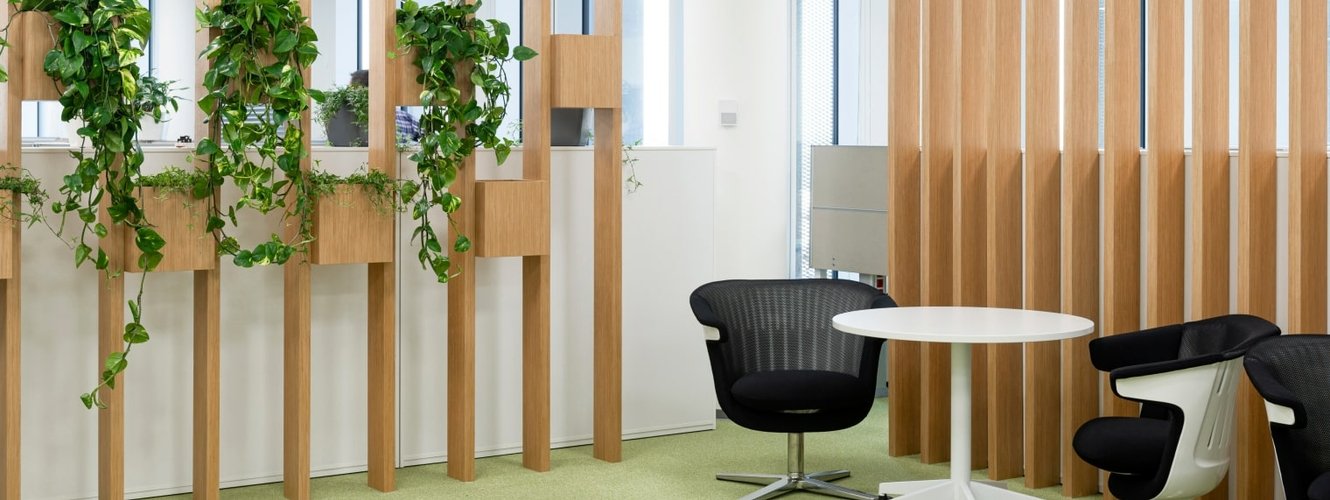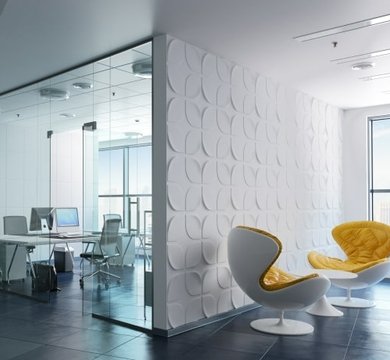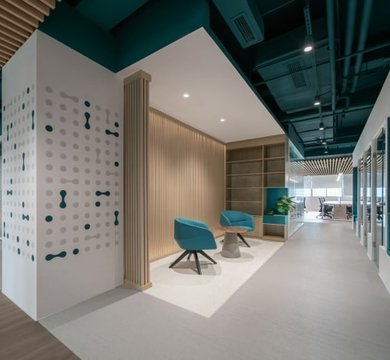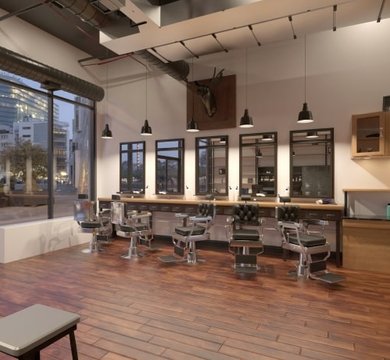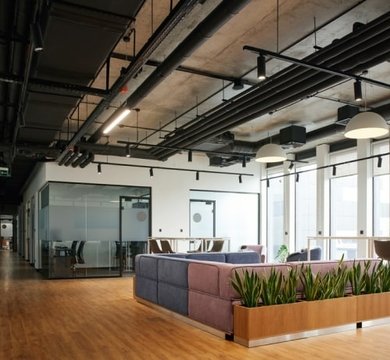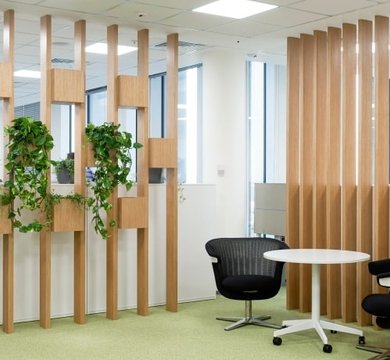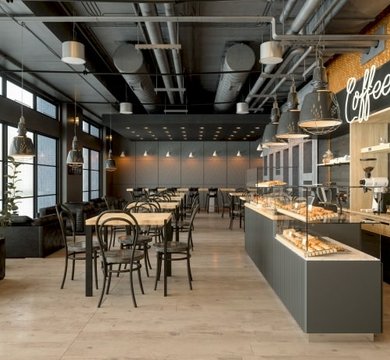Our planet is irreplaceable and we’re finally realising the impact different elements have on the sustainability of where we live and the quality of our lives. We’re pleased to report there has been a dynamic shift in the built environment, with great strides specifically in the commercial office and fit-out sector.
One of those is the introduction of sustainability benchmarking and accreditations. In this article, we take a deep dive into the benefits of a SKA rating. We’ll answer the questions ‘what does ska rating mean?’, ‘how will it benefit my business?’ and ‘how can I achieve a good SKA rating?’
What Does SKA Rating Stand For?
If you’ve heard SKA rating or SKA assessment mentioned in a commercial property conversation, you may wonder what a SKA rating is. The Royal Institute of Chartered Surveyors (RICS) introduced SKA ratings in 2009 as an environmental assessment method.
The initiative serves two purposes: to give property owners and commercial fit-out professionals a practical framework for improving sustainability in refurbishment and interior works; and to give members of the public a clear indication of how sustainable a building is.
Why SKA Rating Matters
Sustainability in commercial buildings is a new, valuable currency, especially when it comes to selling and letting premises. Intrinsic to this are metrics – the process of how we measure each workplace’s environmental impact. Increasingly, stakeholders and potential partners only want to work with companies with validated eco credentials.
A SKA rating is an at-a-glance way of seeing how dedicated a business is to sustainability and corporate social responsibility. A SKA assessment and resulting certificate demonstrates that energy efficiency and carbon production has been addressed during the design, construction and/or fit-out stages.
What is the difference between SKA and BREEAM?
You may be debating which rating pathway to follow and it can be hard to find a difference between SKA rating and BREEAM. We find a SKA rating more flexible and more relevant, as it only applies to retail spaces and office fit-outs. A SKA rating is also easier for the outsider to appraise, having just three levels of achievement, where there are multiple ratings with BREEAM. Additionally, MPL finds BREEAM more suitable for construction projects in the public sector.
SKA Rating Levels
Companies who successfully pass the SKA assessment process will receive one of three SKA ratings - Gold, Silver or Bronze – together with a percentage score.
- Gold: a gold SKA rating proves the highest level of environmental responsibility and efficiency has been achieved, with a comprehensive adoption of sustainability features.
- Silver: a silver SKA rating demonstrates an enhanced sustainability performance, with major progress made towards sustainability goals.
- Bronze: a bronze SKA rating illustrates a company has met minimum sustainability criteria, with a focus on the core objectives.
Commercial fit-outs and office interior design solutions that achieve a high SKA rating will enjoy lower operational costs, achieve better environmental outcomes, comply with ‘green lease’ provisions and appeal to a variety of stakeholders, including current employees, future hires and potential investors.
SKA Assessment Process
A SKA rating has obvious benefits but how do companies start the process, make progress and, crucially, pass the SKA assessment?
How the SKA Assessment Works
It’s a good idea to have an idea of what’s involved in pre-planning and during the SKA assessment. There are three main stages:
- Pre-assessment: this is a scoping stage to identify goals, establish which SKA rating criteria apply to the project and decide how feasible it will be achieve the standard.
- Design & assessment phase: this stage sets out how the goals identified in the pre-assessment stage will be achieved via the choice of materials/products, energy efficiency measures and waste management.
- Post-completion review: evidence collection during the construction/fit-out/refurb stages will be passed on to a SKA rating assessor. They will use this, together with a final assessment, to review the completed project. Compliance with SKA criteria will result in certification.
Key Assessment Criteria
The SKA assessment process focuses on a set of ‘good practice criteria’, known as good practice measures (GPM). There are more than 100 GPM that can be implemented, with some held in higher regard than others. The most important are called ‘gateway measures’ and are essential for achieving certification. The GPM are divided into 8 main categories:
- Energy
- CO2
- Waste
- Water
- Pollution
- Transport
- Materials
- Wellbeing
Initiatives that will help achieve a good SKA rating can include: reducing the number of office chairs that are sent to landfill, retrofitting WCs with water-saving flushes, installing cycle racks and ensuring VOC concentrations are kept low during an office fit-out.
Benefits of SKA Rating for Business Owners
A SKA rating is not just about saving the planet, it will help companies save money and boost brand image.
Cost Savings
Using less energy and improving a building’s efficiency is a straight-forward financial win. Achieving a SKA rating will also involve more sustainable materials, which will reduce the need to keep rebuying and replacing items.
Compliance with Sustainability Standards
Sustainability has moved to the top of almost every business agenda thanks to Government-led carbon neutral initiatives and Minimum Energy Efficiency Standards (MEES), which dictate commercial properties need a mandatory EPC of at least an E. In addition, business reputations are increasingly judged a social conscious, such as achieving B Corp certification. A SKA rating will make it much easier to comply with compulsory legislation and beneficial voluntary initiatives.
Enhanced Workplace Environment
The processes of meeting as many GPMs as possible will naturally result in a happy, healthy workplace. Not only will the air be cleaner, the indoor environment less polluted and lighting more considered, employees will feel reassured knowing they work for a company committed to the environment. Those levels of satisfaction are proven to positively impact overall productivity and wellbeing.
How to Achieve a SKA Rating
So you’ve committed to being kinder to the environment, now to start the process of having your efforts acknowledged.
Assembling the right team
Hiring a refurbishment partner willing to meet SKA benchmarks is essential. MPL’s commercial fit-out and interior design services for retail brands can focus on sustainability and achieving a beneficial SKA rating.
Working with Certified Assessors
RICS operates an accreditation scheme that enables qualified professionals to undertake SKA rating assessments on behalf of organisations. To enhance chances of accreditation success, an assessor can be consulted at the pre-assessment stage to help customise a refit/construction programme. An assessor can also be engaged during the design and assessment phase, during which they can provide an indicative SKA rating prediction.
Preparing for Common Challenges and Finding Solutions
The most successful SKA assessments are those where everyone shares the same goals and vision. Aspects, including budgets and timescales, need agreeing very early in the process. A low SKA rating can be avoided by meticulously examining the credentials of any suppliers, while keeping documentation and tracking sustainability performance during the assessment phase. It’s worth remembering that a Bronze or Silver SKA rating can be upgraded during future assessments via retrofitting.
There are multiple benefits to gaining a SKA rating, including boosting a premise’s chance of securing the mandatory commercial office EPC grade. There’s also a holistic, feel-good factor knowing your place of work has a reduced carbon footprint, is less damaging to the planet and provides a healthy environment for staff. And a lower reliance on utilities means lower fuel bills – vital when it comes to budgeting.
If you would like sustainability advice and examples of our office refurbishments across London & the South East, please get in touch.

